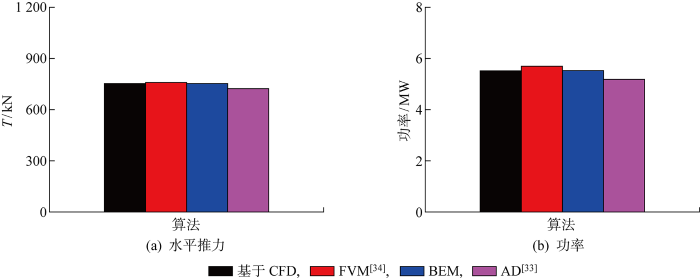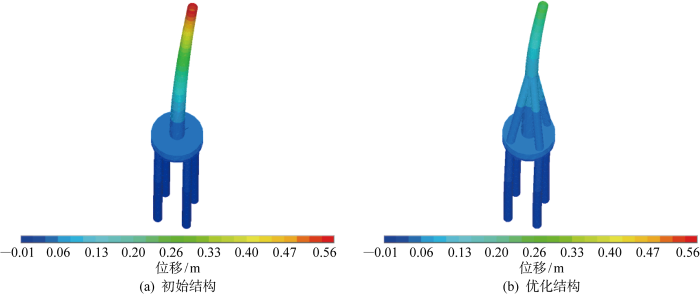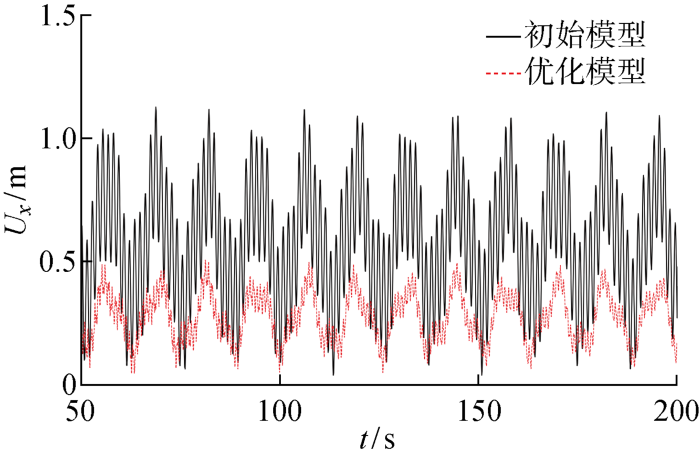研究并优化大型水平轴风力机支撑结构对保证系统运行安全十分重要.风力机大型化导致塔筒顶部大型转子和发电机质量增加、支撑塔筒高度增大.常用的圆锥塔筒无法满足风力机结构的强度和刚度要求.迄今,学者们对大型水平轴风力机支撑结构优化已有一定研究.Gentils等[4]基于遗传算法,考虑多准则约束,对美国国家可再生能源实验室(NREL)提出的5 MW单桩式风力机(NREL 5 MW)塔架和基础进行优化分析并计算风力机支撑结构优化尺寸参数;Oest等[5]基于疲劳损伤荷载、准静态分析和动态分析,对海上风力机支撑结构进行梯度优化设计;葛旭等[6]结合有限元分析与进化策略,对海上三桩单立柱风力机支撑结构主尺度参数进行多参数同步优化设计;Tian等[7]对导管架式海上风力机的导管架基础进行拓扑优化,结合尺寸和形状优化实现结构重分布,得到质量更轻的导管架结构.上述研究仅为针对特定风力机结构形式的参数优化,未改变其支撑结构形式,虽对风力机结构稳定性有一定提高,但设计方法具有局限性.相较于参数优化,拓扑优化方法具有更多的设计自由度,是优化大型水平轴支撑结构的新途径.
考虑桩土相互作用的风力机支撑结构性能,开展支撑结构优化分析.基于反比例型删除率的BESO算法,提出大型高桩承台式水平轴风力机支撑结构拓扑的优化算法,运用有限元软件ANSYS开展大型水平轴风力机支撑结构寻优分析,获得一种风力机优化支撑结构,显著降低了风力机风致动力响应.
1 风力机结构建模与分析
1.1 风力机支撑结构建模
图1
表1 5 MW水平轴风力机塔架参数
Tab.1
| 参数 | 数值 | 参数 | 数值 |
|---|---|---|---|
| 塔筒底部外径,D/m | 6 | 额定输出功率/MW | 5 |
| 塔筒顶部外径/m | 3.87 | 叶片长度,L/m | 61.5 |
| 塔架高度,H0/m | 90 | 额定风速/(m·s-1) | 11.4 |
| 转子质量/kg | 110000 | 额定叶尖速度/(m·s-1) | 80 |
| 机舱质量/kg | 240000 | 塔架质量/kg | 591942 |
参照上海东海大桥海上大型风力发电工程项目采用高桩承台式基础[18],混凝土承台直径D1=20 m,承台厚度S=5 m,设置4根直径d1=3 m、壁厚 t=20 mm的全直钢管基桩,桩基长度 H1=52 m,入土深度h=40 m.承台材料选用C45标号混凝土,弹性模量E=33.5 GPa,密度为2500 kg/m3,泊松比ν=0.2[19],基础模型如图2(a)所示.基于Jung等[20]和Chen等[21]确定土体模型和力学参数:土体浮重度
图2
1.2 风力机支撑结构风荷载
对高桩承台大型水平轴风力机结构系统,基于计算流体动力学(CFD)方法并运用Star-CCM+计算软件[22]数值模拟获得风力机叶片气动荷载,风力机风轮直径为d,选取长方体风场计算域,计算域长度、宽度和高度分别为20d、8d和8d,如图3(a)和3(b)所示.计算域划分共 1700 万个网格.计算域中,风力机叶片圆柱体旋转域在竖平面的直径为1.5d,旋转域高度即顺风向尺度为0.75d;旋转域之外的计算域等其他部分为静止域.对旋转域和静止域设置交界面,采用滑移网格处理风轮运行旋转问题,如图3(c)和3(d)所示.叶片表面采用棱柱层网格,延伸因子为1.3,总厚度为0.08 m,无量纲化壁面距离为y+<1.
图3
式中:Cd为风阻力系数,取值1.2;
1.3 桩土相互作用
美国石油协会(API)规范推荐的土体p-y曲线,即非线性弹簧模型广泛应用于海洋工程桩基设计.引入用于分析风力机支撑结构的桩土相互作用[25],该模型考虑了土体非线性、土层变化和土体种类等因素的影响,软土中各层p-y曲线为
式中:p为深度X处单位桩长的极限水平土抗力标准值;yc为实验室中对未扰动工试样做不排水压缩试验时,其应力达到最大应力一半时的变形;y为泥面以下深度X处桩的侧向水平变形;XR为泥面以下到土抗力减少区域底部的深度;pu为深度X处单位桩长的极限水平土抗力标准值.
对于砂土情况,p-y曲线为
式中:K为地基反力初始模量;A为计入静力荷载和循环荷载条件的参数.
基于API规范的p-y曲线法,计算循环荷载作用情况下的桩侧土抗力,使用ANSYS软件的Combine39单元模拟p-y曲线,该单元是具有非线性功能的单向拉压单元,常用于桩土相互作用模拟.在搭建有限元模型时,根据计算得到的土体p-y曲线参数,每间隔1 m设置一个Combine39土弹簧单元.在桩土相互作用模拟过程中,为简化计算未考虑桩土循环弱化作用及桩端设置竖向简支约束.
1.4 风力机支撑结构系统振动响应
式中:
2 大型水平轴风力机支撑拓扑优化
2.1 BESO算法的数学模型
针对大型水平轴风力机支撑结构优化问题,建立以结构静刚度最大为目标、以结构体积为约束条件的数学力学模型[29],表示为
式中:
2.2 单元灵敏度过滤及更新
为避免产生奇异单元刚度矩阵,算法以xmin代替0表示空单元,在该软删单元的BESO算法[30]中所有单元的材料弹性模量可根据材料插值模型设置为
式中:
单元灵敏度表示增删单元对结构平均柔顺度的影响程度,单元灵敏度大小为单元灵敏度的相对排序,表示为
式中:
为抑制优化过程中出现实体单元与空洞单元交替出现的棋盘格等数值不稳定现象[31],通过权重系数引入节点灵敏度节点概念:
式中:
在迭代过程中,根据节点灵敏度对单元灵敏度进行过滤并更新单元灵敏度,更新过程为
式中:
2.3 基于BESO算法的结构拓扑优化
鉴于水平轴风力机结构系统对称性,将支撑结构三维优化问题转化为二维平面优化,以风力机塔筒支撑形式和支撑点位置为优化对象.将风力机塔筒主轴高度方向和塔筒半径方向围成的平面作为初始设计域,采用ANSYS软件中的4节点Plane182单元对计算模型进行网格划分.设置底部为固定端约束,选取最不利气动荷载作为外部风荷载.采用反比例型删除率优化模型[32]对风力机支撑结构进行拓扑优化:
式中:
在迭代过程中,根据删除率对体积比进行更新
式中:
当迭代结果满足根据体积约束和收敛准则[31]时,终止迭代.为提高迭代效率,设置收敛准则,表示当前迭代步之前10次迭代中平均柔顺度的相对变化量,当目标函数变化随着迭代变化足够小时,则判定迭代结束:
式中:
根据上述计算过程实现基于BESO算法的水平轴风力机支撑结构优化,流程如图4所示.
图4
3 优化前后模型受力特性
3.1 基于BESO算法的支撑结构优化
运用BESO双向渐进结构优化算法,对5 MW大型水平轴风力机塔筒结构(高度为90 m)进行拓扑优化,如图5所示.为防止风力机塔筒顶部发生过大位移,通常对风力机塔筒受弯矩作用较大的底部区域进行加固,所选取的底部拓扑区域为宽度a=10 m、长度b=50 m所围成的平面,以此作为初始设计域Ω,采用4节点Plane182单元进行网格划分.在设计域区域施加外部荷载,包括风力机机舱、转子质量等纵向荷载
图5
图5
塔架结构底部受力及拓扑设计区域
Fig.5
Tower structure force diagram and topology design area
分析拓扑过程中体积比即单元删除量变化和平均柔顺度相对迭代次数的变化历程,如图6所示.拓扑迭代初期,拓扑单元较多,单元删除量较大,拓扑迭代速率较快.随着迭代进行,单元体积比逐渐减小,迭代20次后,结构单元体积比开始趋近于目标体积约束条件,拓扑形态开始稳定,最终得到反比例型删除率的优化模型柔顺度量值为1 557.1 N·m.
图6
图6
迭代过程结构平均柔顺度和体积分数变化
Fig.6
Average flexibility and volume fraction of optimized structure
图7
3.2 优化后风力机支撑结构特性
图8
分别计算优化后支撑结构和原塔筒结构的静力特性,注意到风力机塔筒经受周期性脉动风荷载作用,可将风力机旋转多圈并稳定后叶片对塔筒的水平推力用于计算最不利工况下的塔筒位移, 运用式(1)计算沿风机塔筒高度的风荷载.风力机支撑结构顺风向
图9
图9
初始结构与优化结构位移响应云图
Fig.9
Comparison of displacement of initial structure and optimized structure
3.3 桩土作用优化后支撑结构风致动力响应分析
考虑桩土作用,分析5 MW风力机初始和优化后结构在顺风向和竖向的动力响应.设来流风速为25 m/s,风力机叶片转速为0.664 rad/s,风力机运动周期为9.463 s.风力机旋转6~10圈后气动性能基本稳定,相应的风力机旋转时长为50~200 s.初始和优化后结构的塔筒顶端顺风向位移(Ux)时程曲线如图10所示.计算发现在t=68 s时刻,风力机结构振幅较大.因此分析该时刻优化前后支撑结构的顺风向和竖向位移,得到初始和优化后塔顶顺风向最大位移分别为 1 130 和300 mm,减少73.45%;竖向位移分别为 -49~-26 mm和-18~-8 mm,最大竖向位移减少了63.27%.由此可见,在保持与初始结构体积相同情况下,优化后风力机支撑结构位移明显减少,结构刚度大于初始结构.
图10
图10
初始结构和优化结构的塔顶顺风向位移时程曲线
Fig.10
Comparison of displacement time history curve of two models at the top of tower
考虑桩土作用的初始和优化后结构在50~200 s时段顺风向的速度(vx)响应时程和加速度(ax)响应时程如图11所示.可见优化后结构的速度和加速度响应小于初始结构,风振特性得到显著改善,在风力机旋转多圈如100 s进入稳态后改善效果更明显,如塔顶加速度由初始结构的5.02 m/s2减小为优化后结构的3.8 m/s2,减幅达24%.考虑桩土作用的支撑结构振动效应明显减小,具有较好的减振效果.
图11
图11
初始和优化结构的塔顶顺风向速度时程和加速度时程
Fig.11
Comparison of velocity and acceleration time history curve at the top of tower
4 结论
针对大型高桩承台式水平轴风力机支撑结构系统,运用CFD方法计算风致效应,考虑桩土作用效应,运用基于反比例函数的双向渐进结构优化算法对风力机塔筒支撑结构进行拓扑优化,开展风力机结构系统的静动力响应特性分析,得到结论如下:
(1) 运用基于反比例型删除率的BESO算法并考虑桩土作用影响,开展水平轴风力机塔筒支撑结构拓扑优化,得到风力机支撑结构的新形式.
(2) 优化后支撑结构风致效应明显减小,在保持结构体积不变情况下,优化后支撑结构整体刚度明显提高,塔顶顺风向和竖向静力位移分别减小54.5%和32%,动力分析下塔顶在顺风向和竖向最大位移分别减少73.45%和63.27%.
运用BESO算法进行水平轴风力机支撑结构的二维平面优化,后续将对风力机支撑结构开展三维优化研究.
参考文献
Wind power generation: A review and a research agenda
[J].
DOI:10.1016/j.jclepro.2019.02.015
[本文引用: 1]

The use of renewable energy resources, especially wind power, is receiving strong attention from governments and private institutions, since it is considered one of the best and most competitive alternative energy sources in the current energy transition that many countries around the world are adopting. Wind power also plays an important role by reducing greenhouse gas emissions and thus attenuating global warming. Another contribution of wind power generation is that it allows countries to diversify their energy mix, which is especially important in countries where hydropower is a large component. The expansion of wind power generation requires a robust understanding of its variability and thus how to reduce uncertainties associated with wind power output. Technical approaches such as simulation and forecasting provide better information to support the decision-making process. This paper provides an overview of how the analysis of wind speed/energy has evolved over the last 30 years for decision-making processes. For this, we employed an innovative and reproducible literature review approach called Systematic Literature Network Analysis (SLNA). The SLNA was performed considering 145 selected articles from peer-reviewed journals and through them it was possible to identify the most representative approaches and future trends. Through this analysis, we identified that in the past 10 years, studies have focused on the use of Measure-Correlate-Predict (MCP) models, first using linear models and then improving them by applying density or kernel functions, as well as studies with alternative techniques, like neural networks or other hybrid models. An important finding is that most of the methods aim to assess wind power generation potential of target sites, and, in recent years the most used approaches are MCP and artificial neural network methods. (C) 2019 Elsevier Ltd.
Recent advances in damage detection of wind turbine blades: A state-of-the-art review
[J].DOI:10.1016/j.rser.2022.112723 URL [本文引用: 1]
Integrated structural optimisation of offshore wind turbine support structures based on finite element analysis and genetic algorithm
[J].DOI:10.1016/j.apenergy.2017.05.009 URL [本文引用: 1]
On gradient-based optimization of jacket structures for offshore wind turbines
[J].DOI:10.1002/we.v21.11 URL [本文引用: 1]
基于进化策略的海上风电支撑结构多参数同步优化设计
[J].
Multi-parameter simultaneously optimal design of support structure for offshore wind turbine based on evolutionary strategy
[J].
Optimization design of the jacket support structure for offshore wind turbine using topology optimization method
[J].DOI:10.1016/j.oceaneng.2021.110084 URL [本文引用: 1]
基于改进BESO算法的带隔板薄壁方管耐撞性拓扑优化
[J].
Crashworthiness topology optimization of the thin-walled square tube with diaphragms based on improved BESO algorithm
[J].
基于改进BESO方法的多工况船体开孔孔形优化
[J].
Shape optimization of hull structure hole opening under multiple conditions based on improved BESO method
[J].
Detail control strategies for topology optimization in architectural design and development
[J].
DOI:10.1016/j.foar.2021.11.001
[本文引用: 1]

With the ability to generate forms with high efficiency and elegant geometry, topology optimization has been increasingly used in architectural and structural designs. However, the conventional topology optimization techniques aim at achieving the structurally most efficient solution without any potential for architects or designers to control the design details. This paper introduces three strategies based on Bi-directional Evolutionary Structural Optimization (BESO) method to artificially pre-design the topological optimized structures. These strategies have been successfully applied in the computational morphogenesis of various structures for solving practical design problems. The results demonstrate that the developed methodology can provide the designer with structurally efficient and topologically different solutions according to their proposed designs with multi-filter radii, multi-volume fractions, and multi-weighting coefficients. This work establishes a general approach to integrating objective topology optimization methods with subjective human design preferences, which has great potential for practical applications in architecture and engineering industry.
矶崎新引领世界建筑创新潮流的先锋
[J].
Arata Isozaki is a pioneer in the world of architectural innovation
[J].
海上风力机高桩承台基础反应特性研究
[J].
Study on response of offshore wind turbine with high-pile cap foundation
[J].
Comparison of the dynamic responses of monopiles and gravity base foundations for offshore wind turbines in sand using centrifuge modelling
[J].DOI:10.1016/j.sandf.2020.10.009 URL [本文引用: 1]
Nonlinear dynamical behaviour of jacket supported offshore wind turbines in loose sand
[J].DOI:10.1016/j.marstruc.2017.10.002 URL [本文引用: 1]
波浪与地震荷载共同作用下桩的动力响应
[J].
Dynamic response of pile at waterwave load and seismic load
[J].
Definition of a 5-MW reference wind turbine for offshore system development
[J].
海上风电产业现状及未来发展趋势展望
[J].
Present situation and future development trend of offshore wind power industry
[J].
Effect of monopile foundation modeling on the structural response of a 5-MW offshore wind turbine tower
[J].DOI:10.1016/j.oceaneng.2015.09.033 URL [本文引用: 1]
Analysis of potential conservatism in foundation design for offshore platform assessment
[R].
基于标准k-ε模型的平衡大气边界层模拟
[J].
Application of standard k-ε model to simulate the equilibrium ABL
[J].
A review of offshore wind turbines: Global added capacity, monopile structure foundations stresses and deflection
[J].
A unified set of single step algorithms part 3: The beta-m method, a generalization of the Newmark scheme
[J].DOI:10.1002/(ISSN)1097-0207 URL [本文引用: 1]
Stochastic dynamic response analysis of a floating vertical-axis wind turbine with a semi-submersible floater
[J].DOI:10.1002/we.v19.10 URL [本文引用: 1]
计算结构动力响应的状态方程直接积分法
[J].
Direct integration of state equation method for dynamic response of structure
[J].
Jack-up platform leg optimization by topology optimization algorithm-BESO
[J].
Multi-material topology optimization using ordered SIMP interpolation
[J].DOI:10.1007/s00158-016-1513-3 URL [本文引用: 1]
Elasto-Plastic limit analysis of reliability based geometrically nonlinear bi-directional evolutionary topology optimization
[J].DOI:10.1016/j.istruc.2021.08.105 URL [本文引用: 2]
基于一种动态删除率的ESO方法
[J].
ESO method based on a kind of dynamic deletion rate
[J].
A CFD study into the influence of unsteady aerodynamic interference on wind turbine surge motion
[J].DOI:10.1016/j.renene.2015.12.013 URL [本文引用: 1]
Influences of surge motion on the power and thrust characteristics of an offshore floating wind turbine
[J].DOI:10.1016/j.energy.2017.11.090 URL [本文引用: 1]















